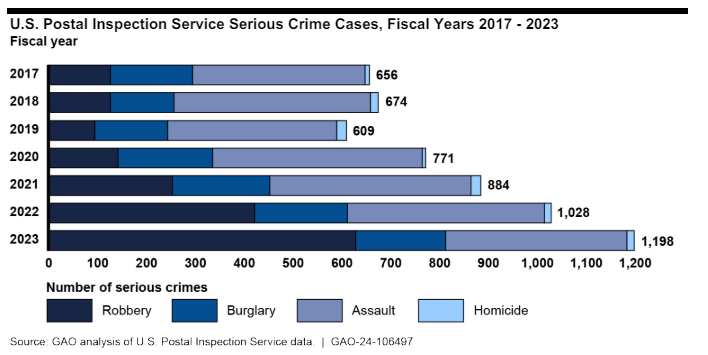Amid crime surge, USPS law enforcement relying on ‘outdated’ data to justify staffing
The number of serious postal crimes — including burglaries, robberies, assaults, and homicides — increased almost every fiscal year between 2017 and 2023.
The Postal Service is seeing a surge in postal crime — including a sevenfold increase in robberies — but relies on outdated crime data to justify the size of its law enforcement workforce, according to a watchdog report.
The Government Accountability Office, in a report publicly released Wednesday, found the number of serious postal crimes — including burglaries, robberies, assaults, and homicides — increased almost every fiscal year between 2017 and 2023.
According to the Postal Inspection Service (USPIS), the Postal Service’s law enforcement agency, USPS saw nearly 1,200 serious postal crimes in 2023 — with robberies of letter carriers accounting for about half of them.

USPIS also opened two homicide cases in 2023, following the deaths of USPS employees killed on the job.
Despite the surge in postal crime, GAO found the overall postal inspector workforce, and the location of those employees, remained “relatively unchanged” during this period — while USPIS has decreased staffing of its postal police workforce.
GAO auditors found USPIS hasn’t assessed the size and location of its postal police workforce, and whether it’s commensurate with its caseload, since 2011. The report says it remains unclear how long USPIS “will rely on outdated information to determine how to align its postal police workforce with current security needs.”
“Until then, the size and location of the postal police workforce are still informed by 2011 information, such as crime rates from that time,” GAO wrote.
USPIS officials agreed with all of GAO’s recommendations, and said they are planning to conduct a new security force assessment, but “could not provide GAO the time frames for doing so.”
Chief Postal Inspector Gary Barksdale told GAO that USPIS will set a timeframe for completing the security force assessment by April 2025. The assessment will help USPIS determine the size and location of its postal inspector and postal police workforce.
GAO found USPIS was in the “early stages” of creating a working group to perform the security force assessment as of February 2024.
“Inspection Service officials said they could not provide us with any time frames — such as the target completion date for an assessment — until the working group is fully established,” GAO wrote.
As part of ongoing “surge operations,” USPIS is sending postal inspectors into hotspots such as Chicago and Oakland to crack down on mail theft and robberies and letter carriers.
However, postal inspectors have opened serious crime cases in almost 500 different metropolitan areas.
“Inspection Service officials, as well as representatives of USPS employee organizations, told us that it is difficult for the Inspection Service to protect letter carriers who deliver mail across a wide geographic area because of limited staff resources,” GAO wrote.
Local police officers are often the first to respond to the scene of crimes against USPS employees and property.
USPIS data shows guns are increasingly involved in postal crimes. Firearms were present in about 68% of robbery cases in 2022 and 66% of cases in 2023. The data shows USPS employees aren’t physically harmed in 95% of robbery cases — but local law enforcement and USPS employee organizations say letter carriers often experience trauma and stress from these armed robberies.
GAO noted a significant uptick in the number of cases where the robber demanded a USPS employee’s arrow key, which is used to open blue collection boxes.
USPIS told GAO that, as of September 2023, it had more than 1,220 postal inspectors — about 14% short of its authorized workforce — and 367 postal police officers — about 37% fewer than authorized.
USPIS has a total workforce of about 2,300 employees — which includes leadership positions, analytics and administrative personnel. Law enforcement personnel make up about 70% of its total headcount.
Postal police generally provide security at USPS properties such as mail processing and distribution centers. USPIS also hires contracted guards to handle security at the entrances and exits of some USPS facilities.
GAO found that postal police also have some limited off-property responsibilities — although that role varies by location, and remains the subject of an ongoing federal lawsuit.
USPIS issued a memo in August 2020 stating postal police are only allowed to conduct law enforcement duties when they are on, or protecting USPS property — and that senior USPIS officials must approve any postal police activity to happen outside USPS property.
Before 2020, USPIS could assign postal police to patrols along carrier routes. But officials told GAO the memo ended any patrols by postal police along letter carrier routes.
The jurisdiction of postal police officers remains at the heart of an ongoing federal lawsuit led by the Postal Police Officers Association.
The U.S. District Court for the District of Columbia, in a February ruling, sent the case back down to a third-party arbitrator to settle.
GAO conducted its report at the request of several Democrats on the House Oversight and Accountability Committee.
USPS is also seeing a surge in mail theft cases, with criminals targeting USPS facilities and blue mail collection boxes.
As part of “Project Safe Delivery,” USPS is installing 49,000 electronic locks on blue collection boxes in several cities.
Criminals in many cases are robbing letter carriers and targeting mail collection boxes to steal personal checks, which they can alter and cash — or sell on online criminal marketplaces.
Copyright © 2025 Federal News Network. All rights reserved. This website is not intended for users located within the European Economic Area.
Jory Heckman is a reporter at Federal News Network covering U.S. Postal Service, IRS, big data and technology issues.
Follow @jheckmanWFED






